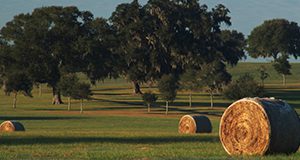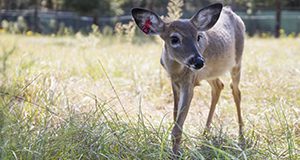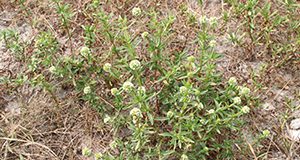The 17th annual Florida Bull Test Sale was held on January 21, 2017 at the conclusion of the 2016-2017 Florida Bull Test. The test evaluated the performance potential and breeding soundness of bulls consigned to the program at the UF/IFAS North Florida Research and Education Center (NFREC). This new 9-page fact sheet discusses test procedures, assessment of feed efficiency, test rules and regulations, health requirements, and test results. Written by Luara B. Canal, G. Cliff Lamb, and Nicolas DiLorenzo, and published by the UF/IFAS Department of Animal Sciences, February 2018.
http://edis.ifas.ufl.edu/an341
Category: Livestock
Effective Use of Genomics in Commercial Dairy Farms
Genomic selection refers to selection decisions based on genomic-estimated breeding values. These genomic breeding values are calculated using genetic markers across the entire genome. This technology has revolutionized dairy cattle breeding globally. This new 4-page fact sheet discusses the effects of genomics on dairy sire selection. Written by Francisco Peñagaricano, and published by the UF/IFAS Department of Animal Sciences, February 2018.
http://edis.ifas.ufl.edu/an340
Risk Management for 4-H Youth Development Work: Large Animals-Horses
This 13-page publication is one in the series Risk Management for 4-H Youth Development Work. It addresses the risks involving horses at 4-H events. Written by Saundra TenBroeck, Wendy DeVito, Dale Pracht, Chad Carr, Brittani Kirkland, and Georgene Bender and published by the UF/IFAS 4-H Youth Development Department, February 2018.
http://edis.ifas.ufl.edu/4h383
How Much Does Bad Hay Cost a Beef Cattle Producer?
Everyone likes a good bargain, but when it comes to hay, low price often equates to low nutritional value. Because hay is often sold on a large round-bale basis, savings from the good bargain can decrease substantially if there is a negative impact on the cow herd nutritional program. This 4-page fact sheet discusses intake limitations, energy limitations, protein limitations, examples of hay quality, and bad hay’s impact on cow body condition. Written by Matt Hersom and Todd Thrift, and published by the UF/IFAS Department of Animal Sciences, February 2018.
http://edis.ifas.ufl.edu/an339
Economic Value of Genetic Merit of Dairy Semen
Attempts to calculate the economic value of semen have been made since at least the 1970s. The basic calculations have since become available (Dechow 2016). This new 3-page fact sheet reviews these calculations, adds a few other considerations, and offers estimates of the worth of the genetics of dairy semen. Written by Albert De Vries, and published by the UF/IFAS Department of Animal Sciences, January 2018.
http://edis.ifas.ufl.edu/an338
Basic Concepts of Dairy Sire Selection
Sire selection is one of the most important decisions that a dairy producer makes. It represents a great opportunity to improve the profitability of the dairy production enterprise. This new 3-page fact sheet reviews some key concepts that should be considered in order to make proper selection decisions and discusses alternative methods for selecting sires based on multiple traits. Written by Francisco Peñagaricano, and published by the UF/IFAS Department of Animal Sciences, January 2018.
http://edis.ifas.ufl.edu/an337
Nutrition at Early Stages of Life Determines the Future Growth and Reproductive Performance of Dairy Calves
For a calf, nutrition during the first few months of its life may permanently change the way organs develop and then have long-term consequences. The concept that metabolic imprinting may permanently affect animal development has substantial economic implications for agriculture. This 6-page fact sheet summarizes some of the research conducted in calf nutrition and its impact on the growth and reproductive performance of dairy calves. Written by Philipe Moriel and Luiz Ferraretto, and published by the UF/IFAS Department of Animal Sciences, December 2017.
http://edis.ifas.ufl.edu/an336
Micronutrients Considerations for Warm-Season Forage Grass Systems in Florida
 Warm-season grasses are vital to livestock production systems and dominate ground cover in tropical and subtropical areas. The objective of this 7-page publication is to provide basic information about the role of micronutrients in warm-season grass production systems in Florida. Written by Jane C. Griffin, Joao Vendramini, Diane Rowland, and Maria L. Silveira and published by the UF/IFAS Agronomy Department, November 2017.
Warm-season grasses are vital to livestock production systems and dominate ground cover in tropical and subtropical areas. The objective of this 7-page publication is to provide basic information about the role of micronutrients in warm-season grass production systems in Florida. Written by Jane C. Griffin, Joao Vendramini, Diane Rowland, and Maria L. Silveira and published by the UF/IFAS Agronomy Department, November 2017.
http://edis.ifas.ufl.edu/ag419
Nutrition at Early Stages of Life Determines the Future Growth and Reproductive Performance of Beef Calves
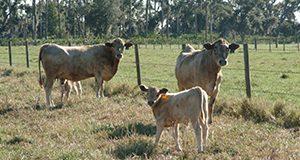 Nutrition can influence future health and performance of calves. The metabolic imprinting concept has substantial economic implications for animal agriculture, and it should be explored to improve the performance of animals bred for food production. This 6-page fact sheet summarizes some of the research conducted in beef calf nutrition and nutritional impact on growth and reproductive performance of beef calves. Written by Philipe Moriel, and published by the UF/IFAS Department of Animal Sciences, October 2017.
Nutrition can influence future health and performance of calves. The metabolic imprinting concept has substantial economic implications for animal agriculture, and it should be explored to improve the performance of animals bred for food production. This 6-page fact sheet summarizes some of the research conducted in beef calf nutrition and nutritional impact on growth and reproductive performance of beef calves. Written by Philipe Moriel, and published by the UF/IFAS Department of Animal Sciences, October 2017.
http://edis.ifas.ufl.edu/an335
Additional Nutritional Considerations for Preconditioning Beef Calves
 Feed ingredient selection is not the only factor to consider during a preconditioning process. Recent studies demonstrated that diet composition and frequency of supplementation can have positive or negative effects on calf performance during preconditioning. This 7-page fact sheet focuses on the ways beef cattle producers can modify the nutritional composition of diets and frequency of concentrate supplementation to optimize growth and immunity of preconditioning beef calves or prevent detrimental effects. Written by Philipe Moriel, and published by the UF Department of Animal Sciences, September 2017.
Feed ingredient selection is not the only factor to consider during a preconditioning process. Recent studies demonstrated that diet composition and frequency of supplementation can have positive or negative effects on calf performance during preconditioning. This 7-page fact sheet focuses on the ways beef cattle producers can modify the nutritional composition of diets and frequency of concentrate supplementation to optimize growth and immunity of preconditioning beef calves or prevent detrimental effects. Written by Philipe Moriel, and published by the UF Department of Animal Sciences, September 2017.
http://edis.ifas.ufl.edu/an334
Genetic Selection for Gaits in the Horse
Quality and cadence of various locomotion patterns are extremely valuable traits in horses. Breeds like the Tennessee Walking Horse, Florida Cracker Horse, Mangalarga marchador, and Icelandic Pony are prized and selected for unique intermediate-speed locomotion patterns. What if genetics could help us unravel and better select for the locomotion patterns of our horses? This 4-page fact sheet discusses the connection between locomotion patterns and genetics, DMRT3 and locomotion in the horse, improvement of understanding of the gene function of DMRT3, and current as well as future applications. Written by Laura Patterson Rosa, Carissa Wickens, and Samantha A. Brooks, and published by the UF Department of Animal Sciences, May 2017.
http://edis.ifas.ufl.edu/an332
Galloping into the Future: Genetic Tips and Tools for the Horse Owner
This 4-page fact sheet discusses the equine genome, determining the genotype of a horse, breeding for certain traits, and the future of genetic tools. Written by Laura Patterson Rosa, Carissa Wickens, and Samantha A. Brooks, and published by the UF Department of Animal Sciences, May 2017.
http://edis.ifas.ufl.edu/an333
Utilization of Biosolids in Forage Production Systems in Florida
This four-page publication provides basic information about land application of biosolids to pastures and hayfields in Florida. The information contained in this document should be of interest to stakeholders, biosolids managers, students, and scientists interested in topics related to biosolids management practices and the potential benefits and risks associated with biosolid land application. Written by Maria L. Silveira, George A. O’Connor, and Joao M.B. Vendramini and published by the Department of Soil and Water Sciences.
http://edis.ifas.ufl.edu/ss658
Rumen Protozoa: The Animals within the Cow
As a cow ambles around and eats from the feed bunk, legions of other “animals” are feeding within the cow’s rumen. Billions of protozoa swim about in a single, 20-gallon rumen, colliding with one another while engulfing feed particles and bacteria. These microbes contribute vitally to rumen fermentation and have both positive and negative impacts on animal performance. This 4-page fact sheet discusses classification, activities, removal, and impacts of protozoa. Written by Timothy J. Hackmann, and published by the UF Department of Animal Sciences, January 2017.
http://edis.ifas.ufl.edu/an331
Trueperella (Arcanobacterium pyogenes) in Farmed White-Tailed Deer
Trueperella is a harmless bacterium in intestinal tracts of ruminants like deer, cattle, and pigs, but if it migrates out of the intestine to other areas of an animal’s body and proliferates, it can make the animal sick. Trueperella causes many problems in deer, including lesions, abscesses, and pneumonia, and it is one of the types of bacteria that is known to contribute to the disease lumpy jaw. In young fawns, it is a common cause of death. This 3-page fact sheet written by Kathryn D. Pothier, Katherine A. Sayler, and Samantha M. Wisely and published by the Department of Wildlife Ecology and Conservation explains how to spot and treat trueperella, or, better yet, prevent it in the first place.
http://edis.ifas.ufl.edu/uw427
The Florida Bull Test 2015-2016
The 16th annual Florida Bull Test Sale was held on January 16, 2016 at the conclusion of the 2015–2016 Florida Bull Test. The test evaluated the performance potential and breeding soundness of bulls consigned to the program at the UF/IFAS North Florida Research and Education Center (NFREC). This 10-page fact sheet covers the test procedures, assessment of feed efficiency, general policies and procedures, health requirements, test results, and sale summary. Written by Carla D. Sanford, G. Cliff Lamb, and Nicolas DiLorenzo, and published by the UF Department of Animal Sciences, November 2016.
http://edis.ifas.ufl.edu/an328
The Food Safety Modernization Act (FSMA) Preventive Controls for Animal Food
The Food Safety Modernization Act (FSMA) was signed into law in January of 2011 and is considered the most sweeping reform of food safety regulations in 70 years. The human food regulations were composed first and, with significant input from industry, academia, and consumer groups as well as other agencies, were then modified to better suit animal food production. In Florida, these new regulations apply to facilities that manufacture, process, pack, or hold food or food ingredients for animals. These facilities may include pet food manufacturers, renderers, ethanol distillers, feed mills, distributors, and others. The primary goal of these regulations is to ensure safe food for the animals, people who handle the feed, and people who consume the final animal products. This 3-page fact sheet discusses requirements, facilities that will most likely be expected to be in compliance, deadlines, development of a food safety plan, and preventive controls qualified individuals. Written by Jason M. Scheffler and Chad Carr, and published by the UF Department of Animal Sciences, December 2016.
http://edis.ifas.ufl.edu/an330
Pre-Breeding Considerations for the Development of Replacement Beef Heifers
 The efficiency of post-weaning development of heifers has a major impact on the overall profitability of cow-calf operations. To ensure satisfactory performance during the first breeding season, replacement heifers must be subjected to an adequate development program. This 3-page fact sheet covers age at puberty, nutrition, target body weight gain, pelvic area measurements, reproductive tract score, and herd health. Written by Pedro L. P. Fontes, Nicky Oosthuizen, Carla D. Sanford, and G. Cliff Lamb, and published by the UF Department of Animal Sciences, November 2016.
The efficiency of post-weaning development of heifers has a major impact on the overall profitability of cow-calf operations. To ensure satisfactory performance during the first breeding season, replacement heifers must be subjected to an adequate development program. This 3-page fact sheet covers age at puberty, nutrition, target body weight gain, pelvic area measurements, reproductive tract score, and herd health. Written by Pedro L. P. Fontes, Nicky Oosthuizen, Carla D. Sanford, and G. Cliff Lamb, and published by the UF Department of Animal Sciences, November 2016.
http://edis.ifas.ufl.edu/an329
2011 South Florida Beef Forage Survey Results
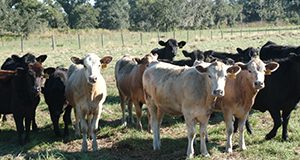 UF/IFAS Extension faculty and state specialists involved in the UF/IFAS South Florida Beef-Forage Program (SFBFP), in conjunction with the UF/IFAS Program Evaluation and Organizational Development unit, created a survey in 1982 that is used to evaluate ranch management practices. The survey is updated and distributed every five years to ranchers in 14 south Florida counties: Charlotte, Collier, DeSoto, Glades, Hardee, Hendry, Highlands, Hillsborough, Lee, Manatee, Martin, Okeechobee, Polk, and Sarasota. There were 102 anonymous responses in 2011. This 6-page fact sheet discusses characteristics of beef operations in south Florida, reproduction, production, marketing, herd health, nutrition, forage production, and environment. Written by Sonja Crawford, Christa Kirby, Tycee Prevatt, Brent Sellers, Maria Silveira, Bridget Stice, Joao Vendramini, and Lindsey Wiggins, and published by the UF Agronomy Department, October 2016.
UF/IFAS Extension faculty and state specialists involved in the UF/IFAS South Florida Beef-Forage Program (SFBFP), in conjunction with the UF/IFAS Program Evaluation and Organizational Development unit, created a survey in 1982 that is used to evaluate ranch management practices. The survey is updated and distributed every five years to ranchers in 14 south Florida counties: Charlotte, Collier, DeSoto, Glades, Hardee, Hendry, Highlands, Hillsborough, Lee, Manatee, Martin, Okeechobee, Polk, and Sarasota. There were 102 anonymous responses in 2011. This 6-page fact sheet discusses characteristics of beef operations in south Florida, reproduction, production, marketing, herd health, nutrition, forage production, and environment. Written by Sonja Crawford, Christa Kirby, Tycee Prevatt, Brent Sellers, Maria Silveira, Bridget Stice, Joao Vendramini, and Lindsey Wiggins, and published by the UF Agronomy Department, October 2016.
http://edis.ifas.ufl.edu/ag410
Biology and Management of Whitehead Broom in Pastures
Whitehead broom, also known as shrubby false buttonweed or southern larraflower, is becoming problematic in south Florida pastures, hayfields, and rights-of-way. This 2-page fact sheet discusses a few options to control this species. Written by Brent Sellers and James McWhorter, and published by the UF Agronomy Department, August 2016.
http://edis.ifas.ufl.edu/ag409



